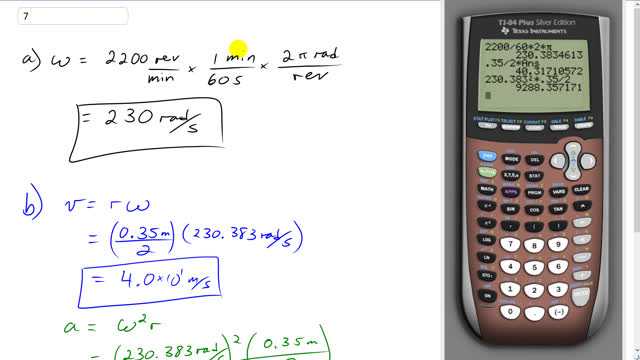
- A grinding wheel 0.35 m in diameter rotates at 2200 rpm. Calculate its angular velocity in rad/s.
- What are the linear speed and acceleration of a point on the edge of the grinding wheel?

In order to watch this solution you need to have a subscription.
This is Giancoli Answers with Mr. Dychko. When converting rpm into radians per second, I always find it helpful to write 'rpm' as revolutions per minute as a fraction like this just to remind myself that it's easy to convert it by multiplying by 1 minute for every 60 seconds and you can see the minutes cancel away then times by 2π radians per revolution— this is one full circle for every revolution— and the revolutions cancel leaving us with radians per second. So we have 230 radians per second. To find the linear speed of a point on the edge of the grinder, multiply the radius by the angular velocity. So that's 0.35 meters—diameter— divided by 2 to get the radius times 230.383; I used all the digits here as you can see, I hit second function negative sign to get the answer from the previous line. So 0.35 over 2 times 230.3834613 and that gives 4.0 times 10 to the 1 meter per second. I could have written 40 meters per second but that would be ambiguous as to the number of significant figures so to make it clear that the 0 is significant, I'm writing 4.0 times 10 to the 1. For the acceleration, the radial acceleration I suppose we should say, is the angular velocity squared times the radius. So that's 230 times 383 radians per second squared times 0.35 over 2—that gives the radius when you divide the diameter by 2— and that gives 9.3 times 10 to the 3 meters per second squared is the radial acceleration.
For part b, how do we know were are looking for the radial acceleration and not the tangential acceleration?
Thanks
Hi daniel.weiss1, thanks for the question. Since the grinding wheel is rotating with a constant angular velocity (2200 rpm) this means there is no tangential acceleration of any point on the edge of the wheel. Points on the edge (or anywhere since there's nothing special about the edge) are all going at a constant speed, in other words. The direction of their velocity is changing, despite the constant speed, and it's the radial acceleration which causes this change in direction.
Hope that helps,
Mr. Dychko